The Necrobiosis Lipoidica Diabeticorum Market is estimated to be valued at USD 5.1 billion in 2025 and is projected to reach USD 9.1 billion by 2035, registering a compound annual growth rate (CAGR) of 6.0% over the forecast period.
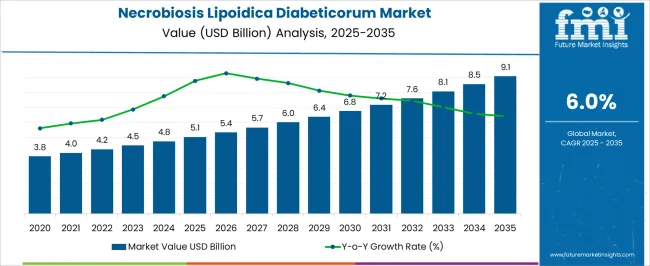
| Metric | Value |
|---|---|
| Necrobiosis Lipoidica Diabeticorum Market Estimated Value in (2025 E) | USD 5.1 billion |
| Necrobiosis Lipoidica Diabeticorum Market Forecast Value in (2035 F) | USD 9.1 billion |
| Forecast CAGR (2025 to 2035) | 6.0% |
The Necrobiosis Lipoidica Diabeticorum market is experiencing a steady expansion, supported by increased clinical recognition and rising diagnosis rates of this chronic granulomatous skin condition often associated with diabetes mellitus. The growing global prevalence of diabetes is directly contributing to the patient pool, thereby increasing demand for targeted interventions. Clinical journals and hospital case studies have highlighted a growing focus among dermatologists and endocrinologists on early diagnosis and proactive treatment of cutaneous complications in diabetic populations.
Advances in topical corticosteroids, immunosuppressants, and laser therapies have also played a significant role in improving treatment outcomes, thereby encouraging more patients to seek medical care. Healthcare institutions are investing in dermatological specialization and expanding care protocols to better address rare dermatological manifestations such as Necrobiosis Lipoidica Diabeticorum.
As a result, awareness among clinicians and patients is gradually increasing, contributing to better identification and management of the condition These evolving dynamics are expected to create continued growth opportunities for treatment providers and care delivery channels across both developed and emerging markets.
The market is segmented by Procedure and Application and region. By Procedure, the market is divided into Treatment and Test Type. In terms of Application, the market is classified into Hospitals and Ambulatory Clinics. Regionally, the market is classified into North America, Latin America, Western Europe, Eastern Europe, Balkan & Baltic Countries, Russia & Belarus, Central Asia, East Asia, South Asia & Pacific, and the Middle East & Africa.
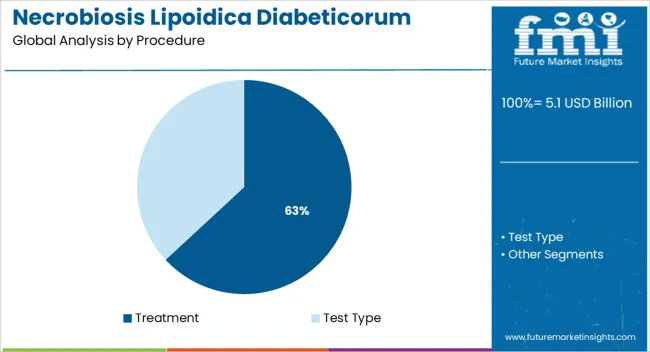
The treatment procedure segment is projected to hold 63.1% of the Necrobiosis Lipoidica Diabeticorum market revenue share in 2025, establishing it as the dominant procedural approach. This leadership is being supported by increasing adoption of medical therapies such as corticosteroids, antiplatelet agents, and immunosuppressive drugs which are prescribed to manage the inflammatory and necrotic aspects of the condition.
Healthcare providers are focusing on treatment protocols that aim to prevent ulceration and skin breakdown, both of which are common in advanced stages of the disease. Clinical guidelines and hospital dermatology departments have emphasized the importance of early intervention to prevent complications and reduce the need for surgical care.
Moreover, improvements in therapeutic compliance and accessibility of specialized dermatological treatment are further reinforcing the uptake of this segment The growing presence of dermatology specialists in diabetic clinics and tertiary hospitals is enhancing diagnosis-to-treatment timelines, ultimately contributing to this segment’s leading position in 2025.
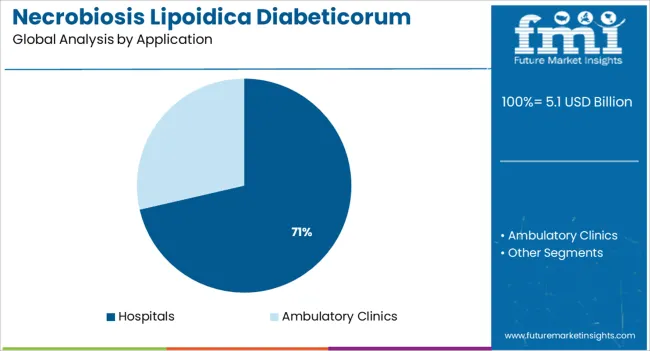
The hospitals application segment is anticipated to account for 71.4% of the Necrobiosis Lipoidica Diabeticorum market revenue share in 2025, making it the primary healthcare setting for diagnosis and treatment. This dominance is being driven by the central role hospitals play in managing complex diabetic conditions that require multidisciplinary care. Patients with Necrobiosis Lipoidica Diabeticorum often present with multiple comorbidities, prompting referral to specialized hospital units for coordinated dermatologic and endocrinologic intervention.
Hospitals are increasingly equipped with advanced imaging, pathology, and therapeutic tools necessary for accurate diagnosis and personalized care. Institutional protocols are prioritizing early dermatological evaluations for diabetic patients, further improving identification rates.
In addition, hospitals provide access to inpatient care when ulceration or secondary infections occur, a factor that strengthens their relevance in advanced cases The availability of skilled clinicians, better diagnostic infrastructure, and comprehensive care models are key contributors to the hospitals segment’s dominant revenue share in the overall market.
According to market research and competitive intelligence provider Future Market Insights- the market for Necrobiosis Lipoidica Diabeticorum (NLD) reflected a value of 4% during the historical period, 2020 to 2025.
Various factors such as awareness in wellness and health, the diagnostics, and pathology segment are improving in developing countries nowadays which grows the therapeutics market. The research and development activities in the field like emerging novel therapeutics, increasing the efficacy of medicine as well as treatment.
Selling campaigns initiated by global players are growing the market progressively. Increasing focus by government organizations and private agencies like WHO and pharmaceutical companies to create awareness of Necrobiosis Lipoidica Diabeticorum (NLD) is fuelling market growth. Thus, the market for Necrobiosis Lipoidica Diabeticorum (NLD) is expected to register a CAGR of 6% in the forecast period 2025 to 2035.
Strong Relation Between Diabetes & Necrobiosis Lipoidica Diabeticorum (NLD) to push the market growth
The increasing prevalence of Necrobiosis Lipoidica Diabeticorum (NLD) disease is one of the biggest drivers of the market. The massive growth in the diabetic population is primarily attributable to rising NLD rates around the world, as well as sedentary lifestyles defined by poor diets and decreased physical exercise.
According to a study conducted by National Center for Biotechnology Information, Necrobiosis lipoidica diabeticorum (NLD) is a rare chronic and granulomatous skin disorder that affects 0.3% of diabetic patients. The legs are the most common site for NLD, but the involvement of other areas such as the abdomen, upper extremities, and scalp has been reported. There is no rational therapy.
Furthermore, a strong relationship between diabetes and NLD, and many studies have focused on diabetic microangiopathy as the leading etiologic theory. Diabetic alterations of the kidney and eye vasculature are similar to the vascular changes seen in NLD. A deposition of glycoprotein in blood vessel walls may be the cause of diabetic microangiopathy.
A similar glycoprotein deposition is seen in NLD. Doppler flow study showed lowered O2 tensions within the lesions.
Considering these in-depth studies, the market is projected to show considerable growth through 2035.
Expensive Cost of Treatment to restrict Market Growth
The expensive treatment of Necrobiosis Lipoidica Diabeticorum (NLD), less awareness of Necrobiosis Lipoidica Diabeticorum (NLD) disease, and insubstantial treatment options are hampering the market growth.
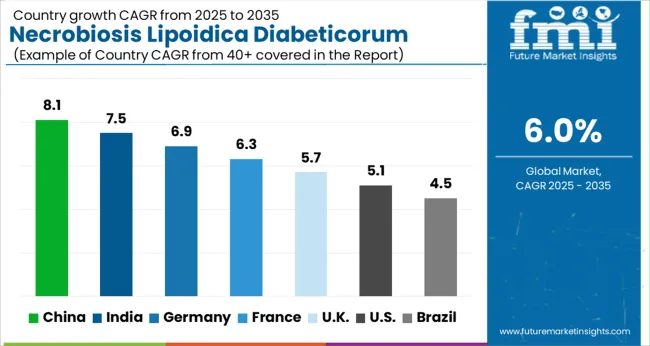
Improvement in healthcare spending propelling the growth of Necrobiosis Lipoidica Diabeticorum (NLD) in Asia Pacific
The Asia Pacific is expected to exhibit a significant growth rate of all regions over the forecast period, with a CAGR of 5% during the forecast period. The growth is owed to increased awareness, significant increases in healthcare spending, and a rising frequency of Necrobiosis Lipoidica Diabeticorum (NLD) in the region. Asia Pacific is an emerging market due to the increase in point care approach to health & care. An increasing number of hospitals in India and China makes a promising market for the treatment market worldwide.
High prevalence of Skin Infections shaping the landscape for Necrobiosis Lipoidica Diabeticorum (NLD) in North America
North America is anticipated to acquire a market share of about 34% in the forecast period. This growth is attributable to the rising prevalence of the condition in the region.
As per the ClinicalTrials.gov posted on January 2024, the study titled "Development of a New Critical Pathway for Treatment of Acute Bacterial Skin and Skin Structure Infections (ABSSSI)" under the clinical development for the drug Dalbavancin from the allergen pharmaceutical in the United States.
Apart from this, An estimated 34.2 million people have diabetes (10.5 percent of the USA population). Therefore, the risk of Necrobiosis Lipoidica Diabeticorum (NLD) rises in the region.
Hospitals to take the lead and drive market growth
The application segment has been divided into hospitals, retail pharmacies, and Ambulatory Surgical Centres. According to the FMI analysis, Hospitals account for the largest market share. The requirement for several hospital stays and visits during NLD treatment facilitates the growth of this segment.
Key start-up players in the Necrobiosis Lipoidica Diabeticorum (NLD) market are-
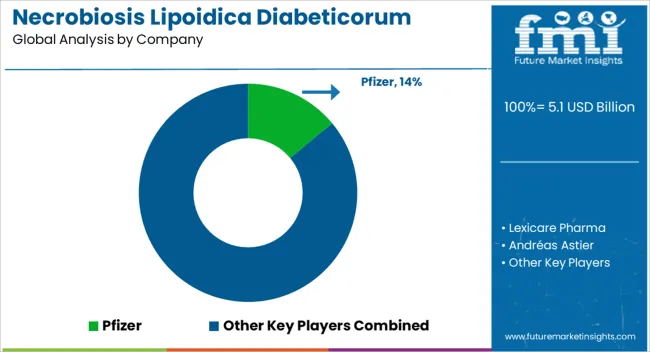
Key players in the Necrobiosis Lipoidica Diabeticorum (NLD) market are ALexicare Pharma, Andréas Astier, Mayo Clinic, AbbVie Inc, Merck & Co., Inc., Bristol-Myers Squibb Company, Johnson & Johnson Services Inc., Pfizer, Novartis AG, and GlaxoSmithKline Plc.
| Report Attribute | Details |
|---|---|
| Market Value in 2025 | USD 5.1 billion |
| Market Value in 2035 | USD 9.1 billion |
| Growth Rate | CAGR of 6% from 2025 to 2035 |
| Base Year for Estimation | 2025 |
| Historical Data | 2020 to 2025 |
| Forecast Period | 2025 to 2035 |
| Quantitative Units | Revenue in USD Million and CAGR from 2025 to 2035 |
| Report Coverage | Revenue Forecast, Volume Forecast, Company Ranking, Competitive Landscape, Growth Factors, Trends, and Pricing Analysis |
| Segments Covered |
Procedure, Application, Region |
| Regions Covered |
North America; Latin America; Europe; Asia Pacific; Middle East & Africa (MEA) |
| Key Countries Profiled | The US, Canada, Brazil, Argentina, Germany, The UK, France, Spain, Italy, Nordics, BENELUX, Australia & New Zealand, China, India, Association of Southeast Asian Nations, GCC, South Africa |
| Key Companies Profiled | Lexicare Pharma; Andréas Astier; Mayo Clinic; AbbVie Inc; Merck & Co., Inc.; Bristol-Myers Squibb Company; Johnson & Johnson Services Inc.; Pfizer, Novartis AG; GlaxoSmithKline Plc. |
| Customization | Available Upon Request |
The global necrobiosis lipoidica diabeticorum market is estimated to be valued at USD 5.1 billion in 2025.
The market size for the necrobiosis lipoidica diabeticorum market is projected to reach USD 9.1 billion by 2035.
The necrobiosis lipoidica diabeticorum market is expected to grow at a 6.0% CAGR between 2025 and 2035.
The key product types in necrobiosis lipoidica diabeticorum market are treatment and test type.
In terms of application, hospitals segment to command 71.4% share in the necrobiosis lipoidica diabeticorum market in 2025.






Our Research Products

The "Full Research Suite" delivers actionable market intel, deep dives on markets or technologies, so clients act faster, cut risk, and unlock growth.

The Leaderboard benchmarks and ranks top vendors, classifying them as Established Leaders, Leading Challengers, or Disruptors & Challengers.

Locates where complements amplify value and substitutes erode it, forecasting net impact by horizon

We deliver granular, decision-grade intel: market sizing, 5-year forecasts, pricing, adoption, usage, revenue, and operational KPIs—plus competitor tracking, regulation, and value chains—across 60 countries broadly.

Spot the shifts before they hit your P&L. We track inflection points, adoption curves, pricing moves, and ecosystem plays to show where demand is heading, why it is changing, and what to do next across high-growth markets and disruptive tech

Real-time reads of user behavior. We track shifting priorities, perceptions of today’s and next-gen services, and provider experience, then pace how fast tech moves from trial to adoption, blending buyer, consumer, and channel inputs with social signals (#WhySwitch, #UX).

Partner with our analyst team to build a custom report designed around your business priorities. From analysing market trends to assessing competitors or crafting bespoke datasets, we tailor insights to your needs.
Supplier Intelligence
Discovery & Profiling
Capacity & Footprint
Performance & Risk
Compliance & Governance
Commercial Readiness
Who Supplies Whom
Scorecards & Shortlists
Playbooks & Docs
Category Intelligence
Definition & Scope
Demand & Use Cases
Cost Drivers
Market Structure
Supply Chain Map
Trade & Policy
Operating Norms
Deliverables
Buyer Intelligence
Account Basics
Spend & Scope
Procurement Model
Vendor Requirements
Terms & Policies
Entry Strategy
Pain Points & Triggers
Outputs
Pricing Analysis
Benchmarks
Trends
Should-Cost
Indexation
Landed Cost
Commercial Terms
Deliverables
Brand Analysis
Positioning & Value Prop
Share & Presence
Customer Evidence
Go-to-Market
Digital & Reputation
Compliance & Trust
KPIs & Gaps
Outputs
Full Research Suite comprises of:
Market outlook & trends analysis
Interviews & case studies
Strategic recommendations
Vendor profiles & capabilities analysis
5-year forecasts
8 regions and 60+ country-level data splits
Market segment data splits
12 months of continuous data updates
DELIVERED AS:
PDF EXCEL ONLINE
Ulcerated Necrobiosis Lipoidica Management Market Trends - Growth & Forecast 2025 to 2035

Thank you!
You will receive an email from our Business Development Manager. Please be sure to check your SPAM/JUNK folder too.
Chat With
MaRIA